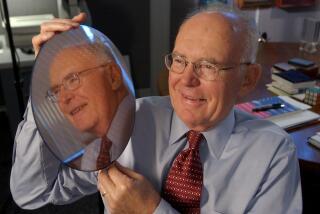The Issues Confronting Hyatt’s Computer-Chip Case
- Share via
The Commissioner of Patents and Trademarks Has received an application for a patent for a new and useful invention. The title and description of the invention are enclosed. The requirements of law have been complied with, and it has been determined that a patent on the invention shall be granted under the law.
If Gilbert P. Hyatt’s patent is challenged in court, here are some of the issues that the court would likely consider, according to patent law experts:
Prior art, or previous inventions: Did Hyatt really invent the computer on a chip before Intel Corp., Texas Instruments and others in the industry?
Hyatt’s patent will be difficult to attack because Hyatt has the benefit of the earliest known filing date, Dec. 28, 1970, for a microprocessor-related application, said Susan Nycum, a Palo Alto patent attorney. However, if either Intel or TI can show that they started work on their products before Hyatt did in 1968, and diligently carried them through to conclusion, they could prevail even though they filed later.
If Hyatt amended his claims later to clarify his invention, does he deserve the benefit of the 1970 filing date? Hyatt notes that his first filing stated the invention would be built on a single integrated circuit chip; opponents, however, could challenge the patent office’s assessment of his original claims.
Claim construction: Are the claims listed in Hyatt’s patent broad enough to cover the entire microprocessor market and other devices such as microcontrollers?
Michael A. Ladra, a patent attorney in Palo Alto, said the claims appear broad-based, but potential opponents may try to argue that the patent does not apply to Reduced Instruction Set Computing microprocessors, which use a different architectural approach as well as certain high-performance microprocessors made by Intel.
Obviousness and reduction to practice: Is Hyatt’s device an invention that improved upon the state of the art at the time? Some critics say no. Federico Faggin, one of the Intel inventors, said that the idea of building a computer on a chip was commonplace. The real breakthrough, he claims, was fabricating the device so that it was economical.
Did Hyatt patent a pipe dream or did he create a working device? Even though Hyatt’s device was never available commercially, for the purposes of patent law, a filing that describes an invention that can be built and which will function as claimed is adequate for reduction to practice. It does not have to prove itself a commercial success.
Enablement: Could a person of ordinary skill in the industry have built Hyatt’s chip from the information contained in the original filing? This issue delayed issuance of the patent for about two years, but Hyatt eventually was able to satisfy the patent examiners.
Because Hyatt did not describe how the chip would be built, the patent examiners doubted that a chip with 2,000 transistors for a processor and an estimated 10,000 transistors for memory could have been built at the time without further experimentation.
However, Hyatt showed that his design had resolved the “pin problem.” This problem involved how to pack thousands of transistors on a tiny chip and still have room for the bulky connecting pins needed to transfer data on the chip. Hyatt figured a way to transmit data between transistors on a kind of time-sharing basis to accommodate all the transistors with only 34 pins.
He also provided documentation to show that electronics companies in the early 1970s had the technology to build the chip he designed. Other sources disagree with Hyatt’s assessment of the importance of serial data transmission, noting that later processors used parallel transmission.





